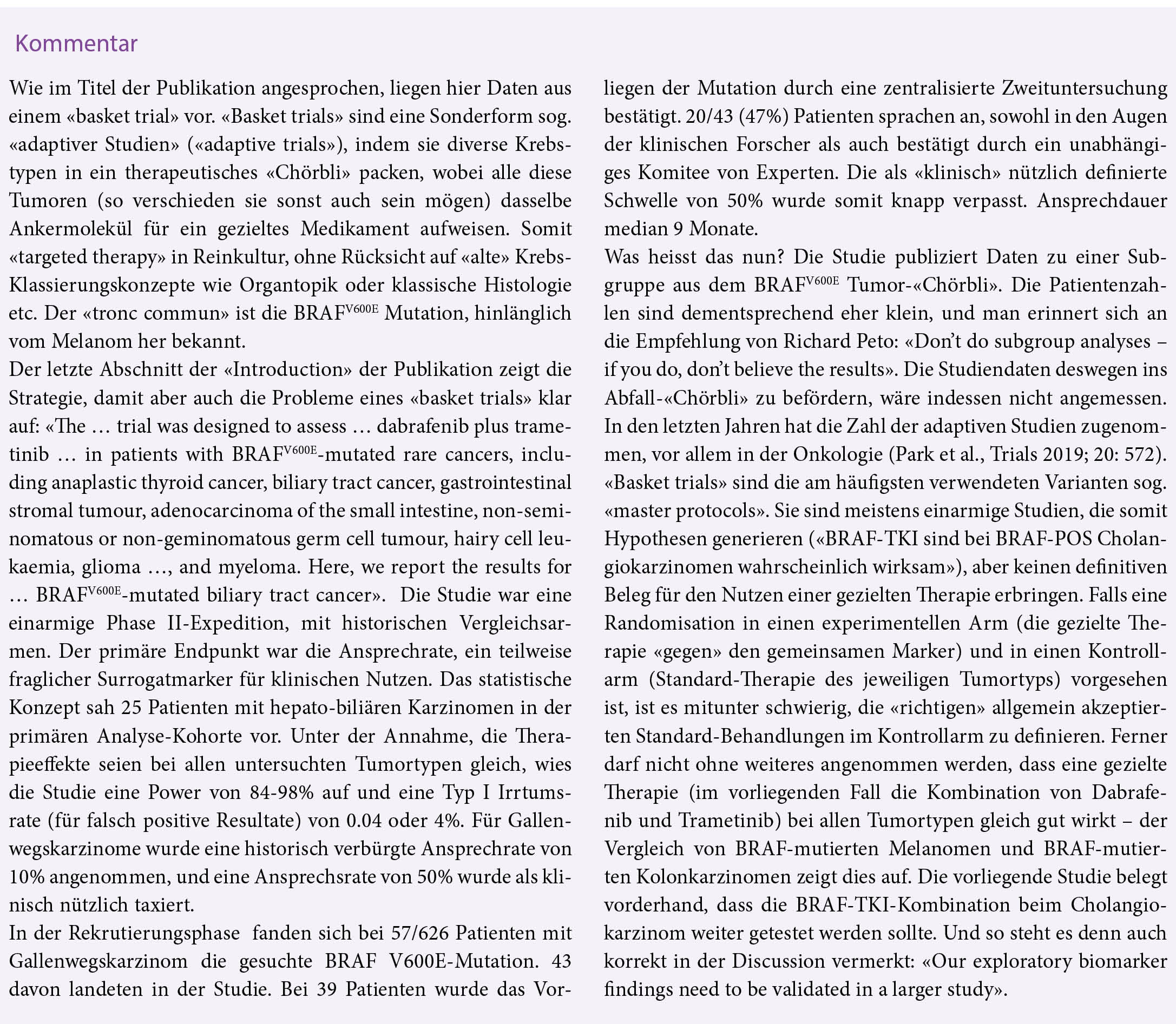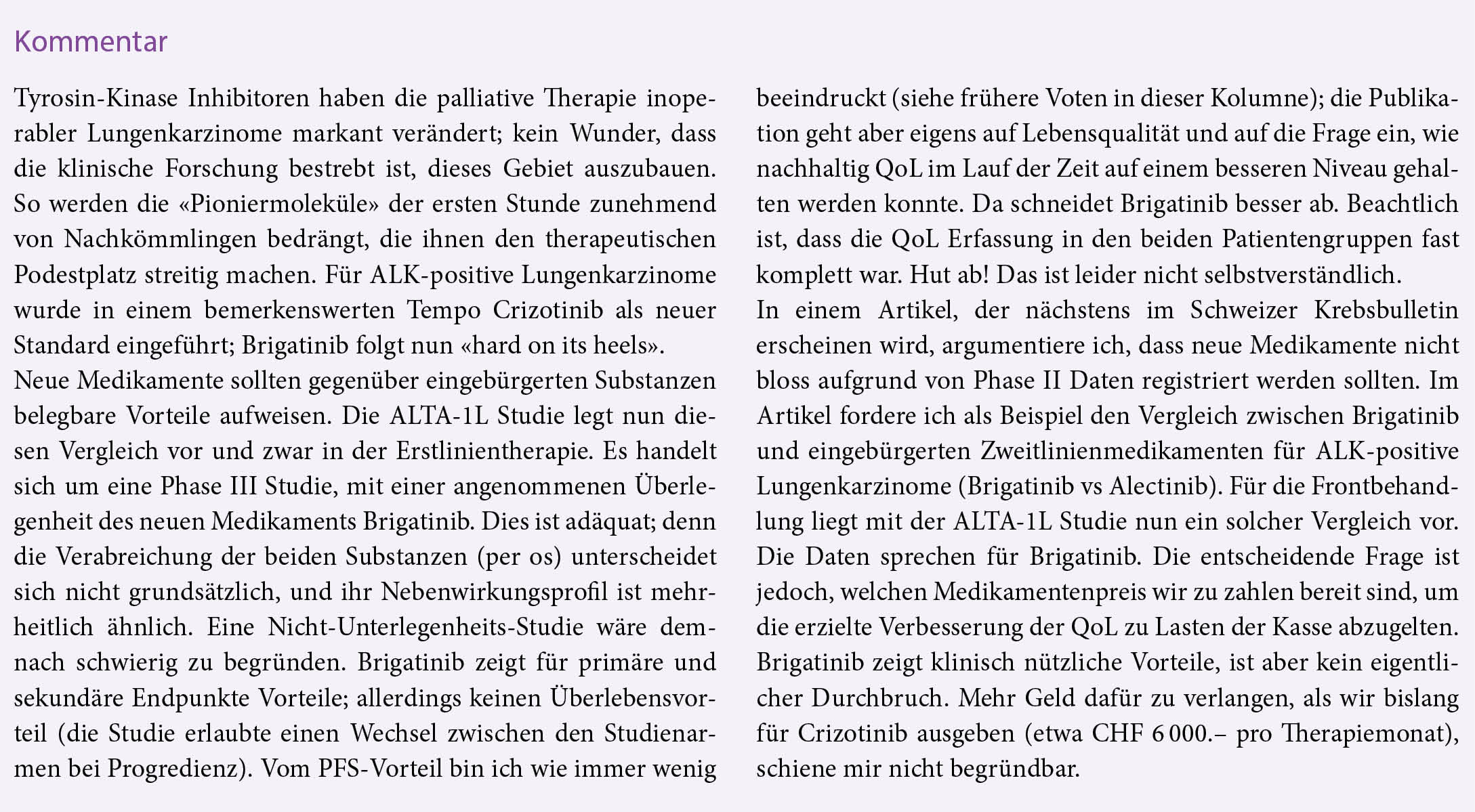- Die Probleme mit «basket trials»
Die Probleme mit «basket trials»
Subbiah V et al. Dabrafenib plus trametinib in patients with BRAFV600E-mutated biliary tract cancer (ROAR): a phase 2, open-label, single-arm, multicentre basket trial. Lancet Oncol 2020 (August 17), https://doi.org/10.1016/ S1470-2045(20)30321-1
Zusammenfassung (im Original): Dabrafenib plus trametinib combination treatment showed promising activity in patients with BRAFV600E-mutated biliary tract cancer, with a manageable safety profile. Routine testing for BRAFV600E mutations should be considered in patients with biliary tract cancer.
Brigatinib folgt Crizotinib «hard on its heels»
Camidge DR et al. Brigatinib versus Crizotinib in advanced ALK inhibitor–naive ALK-positive Non–Small Cell Lung Cancer: second interim analysis of the phase III ALTA-1L trial. J Clin Oncol 2020 (Au-gust 11): DOI https://doi. org/10.1200/JCO.20. 00505.
Zusammenfassung (im Original): Brigatinib represents a once-daily ALK inhibitor with superior efficacy, tolerability, and QoL over crizotinib, making it a promising first-line treatment of ALK-positive NSCLC.
Nachhaltige Effekte einer einmaligen Koloskopie
Pilonis ND et al. Long-term colorectal cancer incidence and mortality after a single negative screening colonoscopy. Ann Intern Med 2020; 173: 81-91.
Zusammenfassung (im Original): A single negative screening colonoscopy was associated with reduced colo-rectal cancer incidence and mortality for up to 17.4 years. Only high-quality colonoscopy yielded profound and stable reductions in CRC incidence and mortality throughout the entire follow-up.
«Eating Beef causes Colon Cancer!»
Thorel M et al. Clouded leopard (Neofelis nebulosa) morbidity and mortality in captive-bred populations: a comprehensive retrospective study of medical data from 271 individuals in European, Asian, and Australian zoos. J Zoo Wildlife Med 2020; 51: 150-158.
Benjamin B. Norton BB et al. Causes of morbidity in captive African lions (Panthera leo) in North America, 2001–2016. Zoo Biology 2018; 37: 354–359.
Owston, M. A., Ramsay, E. C., & Rotstein, D. S. (2008). Neoplasia in felids at the Knoxville zoological gardens, 1979–2003. J Zoo Wildlife Med 2008;
39: 608–613.
Zusammenfassung: Bei 271 in Zoos verstorbenen Nebelpardern (Abb. 1) fand sich nur in 7% der Tiere eine maligne Neoplasie (am häufigsten Phäochromozytome oder Plattenepithelkarzinome der Pfoten), darunter kein einziges gastro-intestinales Karzinom. Nur 21 von 111 Löwen in US-Zoos litten an einem malignen Tumor, meistens an hepatobiliären, endokrinen und gynäkologischen Karzinomen, ferner malignen Lymphomen. Bei 47 euthanasierten Raubkatzen im Zoo von Knoxville TN (US) fanden sich 24 Malignome, darunter aber nur 3 Karzinome des GIT.
Bern
martin.fey@insel.ch
Beratungsmandat bei Nestlé Health Sciences, Epalinges, Aktien von Novartis, Roche und Johnson & Johnson











